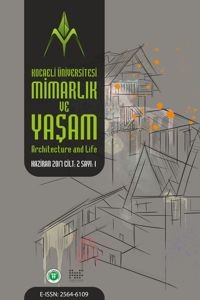Sürdürülebilir Okul Öncesi Eğitim Yapılarının Sosyal ve kültürel Sürdürülebilirlik Açısından İncelenmesi
Öz
20. yy’da artan nüfus ile birlikte doğal
enerji kaynakları kullanımının artması ve ilerleyen teknoloji ile yeryüzünün
doğal kaynaklarının hızla azalması çevre sorunlarının önemli ölçüde artmasına
neden olmuştur. Bu kapsamda kaynakları
en az tüketecek, çevreyi koruyacak ve sürdürülebilirliğini sağlayacak çözüm
yolları için yoğun çalışmalar yapılmaktadır. Sürdürülebilirlik çalışmaları
1980’lerden itibaren pek çok yapı üzerinde yoğunlaşmıştır. Bu yapılardan biri
de eğitim yapılarıdır. Çevreye duyarlı, eğitim kalitesini ve çocukların
sağlığını korumayı amaç edinmiş eğitim yapıları; gerek şimdiki genç nesil,
gerekse de gelecek kuşaklar için daha bilinçli ve sağlıklı bir dünya
yaratılması açısından önem taşımaktadır.
Bunu başarmanın ilk adımı ise; okul öncesi eğitimden başlayarak bütün okulları
sürdürülebilir anlayışla tasarlamak ve öğrencilere sürdürülebilir eğitim
anlayışını benimsetmektir. Sürdürülebilir eğitim yapıları üzerindeki
çalışmalar, diğer yapı tiplerinde olduğu gibi toplam sürdürülebilirliği
oluşturan ekonomik, ekolojik, sosyal- kültürel sürdürülebilirlik üzerinde
yoğunlaşarak devam etmektedir. Yapıların farklı iklim bölgelerinde ve arazi
şartlarında konumlanması, çevrelerindeki potansiyellerin farklılığı, yapılar
için ayrılan bütçelerin değişkenliği gibi sebeplerle bazı sürdürülebilirlik
bileşenlerinin ve bunlara ait kriterlerin ön plana çıktığı görülebilmektedir. Çalışmada
bu kapsamda, sürdürülebilirliğin sosyal ve kültürel sürdürülebilirlik bileşeni
ele alınmıştır. Çalışmanın amacı bu bileşenin ve içerdiği faktörlerin dünya mimarlık
literatüründen seçilen başarılı ‘’sürdürülebilir okul öncesi eğitim
binaları’’nın tasarımına, bulunduğu topluma ve çevreye etkisinin incelenmesi ve değerlendirmesidir.
Anahtar Kelimeler
Sürdürülebilirlik Sosyal ve Kültürel Sürdürülebilirlik Sürdürülebilir Eğitim
Kaynakça
- Ateşoğlu, İrfan, ‘’Şehir Markası Oluşturmada Sembol Yapıların Etkisi’’, Yerel Siyaset, 4, 2008, s.n.y.
- Aydın, Dicle, Okuyucu, Ebru, ‘’Yeniden Kullanıma Adaptasyon ve Sosyo-Kültürel Sürdürülebilirlik Bağlamında Afyonkarahisar Millet Hamamının Değerlendirilmesi”, Megaron, Yıldız Teknik Üniversitesi Mimarlık Fakültesi, İstanbul 2009, s. 35-44.
- Becker, Egon, Jahn, Thomas, Stiess, Imanuel, “Exploring Uncommon Ground: Sustainability and the Social Sciences”, Sustainability and the Social Sciences, Becker, Egon and Jahn, Thomas (Eds.), Zed Books, London 1999, s.4-14.
- Bilge, Cenk, Sürdürülebilir Çevre ve Mimari Tasarım: Mimariye Eleştirel Bir Bakış, İstanbul Teknik Üniversitesi Fen Bilimleri Enstitüsü, Mimarlık Anabilim Dalı, Yüksek Lisans Tezi, İstanbul 2007.
- Blundell Jones, Peter,“Lifelong Learning’’, Architectural Review, London 2001, s.54-59.
- C.I.B, Agenda 21 on Sustainable Construction, C.I.B. Report Publication 237, Rotterdam 1999.
- Çahantimur, Arzu, Sürdürülebilir Kentsel Gelişmeye Sosyo-Kültürel Bir Yaklaşım: Bursa Örneği, İstanbul Teknik Üniversitesi Fen Bilimleri Enstitüsü, Mimarlık Anabilim Dalı, Doktora Tezi, İstanbul 2007.
- Du Plesis, Chrisna, The Meaning And Definition Of Sustainable Development İn The
- Built Environment, University Of Pretoria, CSIR Building And Construction Technology, Master Thesis, Pretoria, South Africa 1998.
- Gelfand, Lisa, Freed, Eric Corey , 2010, Sustainable School Architecture: Design for Elementary and Secondary Schools, Wiley Academy 2010.
Analysis Of Sustainable Preschool Education Buildings in Terms Of Social and Cultural Sustainability
Öz
Increase in the use of natural energy resources
in 20th century with the increasing population and advancing technology and
decrease of natural resources of the earth expeditously, caused environmental
problems to increase substantially. In this context intense studies have been
implemented for solutions that would least consume these resources, provide the
sustainability and protect the environment. Sustainability studies have
concentrated on various buildings beginning from 1980s. One of these buildings
is educational buildings. The
first step in achieving this is to design all of the schools with a sustainable
understanding and make students to adopt the sustainable education
understanding beginning from the preschool education period. Studies on
sustainable educational buildings continue by concentraing on economic,
ecological, social and culturalsustainability which constitute total
sustainability as they are in other buildings types. Educational buildings that
are sensitive to the environment, aimed at preserving the quality of education
and the health of children have an important place in terms of
creating a more conscious and healthy world for both the current young
generation and future generations. Some
sustainability components and
their criteria stand out because of some causes such as the buildings
being located in different climate areas and land conditions, the differences
of the potentials around their environments, variability of the budgets
allocated for the buildings. Within
this scope, the study has been discussed social and cultural sustainability
components of sustainability. The purpose in this study is to evaluate and examine
the effect of social and cultural sustainability components, and the factors it
consists of , to the areas successful
''sustainable preschool educational buildings” selected from architectural world
literature, the society it belongs and environment
Anahtar Kelimeler
Sustainability Social and Cultural Sustainability Sustainable Education Preschool Education Buildings
Kaynakça
- Ateşoğlu, İrfan, ‘’Şehir Markası Oluşturmada Sembol Yapıların Etkisi’’, Yerel Siyaset, 4, 2008, s.n.y.
- Aydın, Dicle, Okuyucu, Ebru, ‘’Yeniden Kullanıma Adaptasyon ve Sosyo-Kültürel Sürdürülebilirlik Bağlamında Afyonkarahisar Millet Hamamının Değerlendirilmesi”, Megaron, Yıldız Teknik Üniversitesi Mimarlık Fakültesi, İstanbul 2009, s. 35-44.
- Becker, Egon, Jahn, Thomas, Stiess, Imanuel, “Exploring Uncommon Ground: Sustainability and the Social Sciences”, Sustainability and the Social Sciences, Becker, Egon and Jahn, Thomas (Eds.), Zed Books, London 1999, s.4-14.
- Bilge, Cenk, Sürdürülebilir Çevre ve Mimari Tasarım: Mimariye Eleştirel Bir Bakış, İstanbul Teknik Üniversitesi Fen Bilimleri Enstitüsü, Mimarlık Anabilim Dalı, Yüksek Lisans Tezi, İstanbul 2007.
- Blundell Jones, Peter,“Lifelong Learning’’, Architectural Review, London 2001, s.54-59.
- C.I.B, Agenda 21 on Sustainable Construction, C.I.B. Report Publication 237, Rotterdam 1999.
- Çahantimur, Arzu, Sürdürülebilir Kentsel Gelişmeye Sosyo-Kültürel Bir Yaklaşım: Bursa Örneği, İstanbul Teknik Üniversitesi Fen Bilimleri Enstitüsü, Mimarlık Anabilim Dalı, Doktora Tezi, İstanbul 2007.
- Du Plesis, Chrisna, The Meaning And Definition Of Sustainable Development İn The
- Built Environment, University Of Pretoria, CSIR Building And Construction Technology, Master Thesis, Pretoria, South Africa 1998.
- Gelfand, Lisa, Freed, Eric Corey , 2010, Sustainable School Architecture: Design for Elementary and Secondary Schools, Wiley Academy 2010.
Ayrıntılar
| Birincil Dil | Türkçe |
|---|---|
| Konular | Mimarlık |
| Bölüm | Kapak |
| Yazarlar | |
| Yayımlanma Tarihi | 30 Haziran 2017 |
| Yayımlandığı Sayı | Yıl 2017 Cilt: 2 Sayı: 1 |


